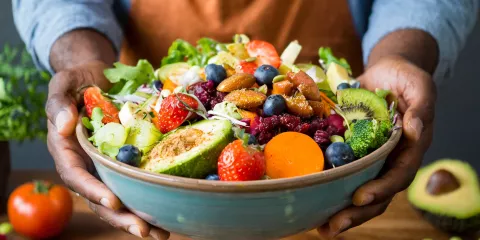
Intuitive eating (or mindful eating) has emerged in popularity within the last decade. It’s touted to improve your relationship with food, which seems like a good thing, right?
In this post, we’ll give you an overview of intuitive eating. This includes what it is, how to follow it safely and additional information about difficulty and supplementation. We hope this post empowers you to make individualized dietary decisions alongside your healthcare provider.
We hope this post empowers you to make individualized dietary decisions alongside your healthcare provider.
What Is Intuitive Eating?
Intuitive eating is a way to listen to your body and combat emotional eating by avoiding restrictive behaviors and savoring your food.1 It centers around the idea that most people are out of touch with natural hunger and fullness cues. It is a means to restore that natural rhythm and improve your relationship with food.2
To identify the difference between emotional eating and intuitive eating, here is an example: You had a bad day, so you grab a tub of ice cream. You eat ice cream in front of the TV, finish the tub and still feel unsatisfied. That’s emotional eating. With intuitive eating, you allow yourself to have ice cream, but you savor it and find the right amount for you to decide it’s enough.
Intuitive eating (or “mindful eating”) is not a diet, but rather, an approach to changing your behavior around food. It is generally considered a positive practice, even by trusted nutrition organizations.3,4
The goal of intuitive eating is to rid yourself of guilt, chaos, disappointment and ulterior motives around food. Ulterior motives include eating for weight loss or eating foods because they are “good for you.” Registered Dietitian Aaron Flores writes it best, “Nutritionally, all foods are different. Emotionally though, all foods must be equal.”2
Intuitive eating is meant to restore peace around food and to build trust that your body will tell you when you’re hungry and full.2,5
Related: 1 Easy Way To Make Cooking More Fun
How to Eat Intuitively (Safely)
Now, let’s talk about how to eat mindfully with a simple step-by-step. We’ve summarized the steps below, although some authors may list them in a different order.
Related: What Is Meditation and How Does It Help Your Mental Health?
Step 1: Avoid Excessive Hunger
A key principle of intuitive eating is to eat when you are hungry, but not too hungry. If you put off your meal until you are ravenous, you’ll be more likely to overeat and be driven by intense cravings.6
Intuitive eating encourages you to avoid scheduling meals, but try to eat when you are moderately hungry. This can be challenging if you are bound by your work schedule, children or other responsibilities.
Step 2: Create a Peaceful Environment
Create a mealtime environment that is peaceful, calm and void of distraction. And again, try to have this environment created before you’re ravenous!
Turn off the TV, step away from the computer and put your phone away. Minimize any distractions that pull your attention away from the meal.
Instead of eating at your desk or while driving, intuitive eating encourages you to sit at a table.
Step 3: Clear Your Mind
Before eating, practice eliminating limiting beliefs about food, such as:6
- “This food will make me lose/gain weight.”
- “This food is good/bad.”
- “This food makes me a ‘failure’ if I eat it.”
- “I need to diet.”
- “I shouldn’t be eating this.”
- “This meal has so many carbs and calories.”
Come to the meal without judgment or guilt about what you’re eating. Instead, think about all the nourishment and enjoyment you’re about to experience.
However, try to avoid tipping towards the other end of the scale with thoughts such as:
- “This food will give me tons of vitamin C.”
- “This food is super low-calorie, so that’s great.”
- “I chose all clean ingredients.”
- “It won’t taste good, but it’s super healthy for me.”
Intuitive eating is about finding peace, enjoyment and acceptance around food. This acceptance could mean that your meal is not the most nutrient dense, but it still makes your body feel good.6 Finding the balance between eating for happiness and eating for health is difficult.
Step 4: Take Note of Your Hunger Level
Before you take that first bite, bring awareness to your current hunger level. Are you starving? Are you not really that hungry?
Ideally, you start the meal moderately hungry. Finding the perfect level of hunger before a meal takes time, so it’s good to check in with yourself.
Step 5: Allow Yourself to Eat
Here is where you may experience a flood of anxiety, guilt or intrusive thoughts, but continue trying to push those aside.
Focus on the food in front of you. Make the meal enjoyable. After all, food is meant to nourish your body and soul!
When you can find enjoyment in what you’re eating (without guilt) this pleasure can help you feel more satisfied with your meal.6
If you find yourself wanting to restrict how much you eat, try to allow yourself to eat as much as you want – as long as you measure your fullness. (See step 7.)
Step 6: Check in with Your Sensations
As you eat, focus on one bite at a time. Take your time while eating. Stop to look at your food. Is it inviting? Take in the aromas. Do the aromas entice you to eat it?
Then, chew your food, focusing on flavors big and small.5 How does the food feel in your mouth? Which flavors are prominent and which are subtle? Do the flavors change as you chew?
Step 7: Assess Your Hunger
Give yourself plenty of time to enjoy the meal. Try to find a time where you won’t feel rushed.
Occasionally check in with your hunger and fullness cues.5 Tune into your body to see when you feel content, but not overly full. Pause during the meal a few times to assess your hunger levels.6
Once you feel comfortably full, end the meal. “Comfortably full” may feel like your stomach is about 80% full.
Intuitive Eating FAQs
We’ll answer some commonly asked questions about intuitive eating so you can better determine if it’s right for you.
What Are the Benefits of Intuitive Eating?
There are a variety of benefits of intuitive eating, including:
- It’s not a diet: Intuitive eating is a lifelong practice and philosophy, rather than a “eat this, not that” diet. This new approach may help you reframe your behaviors around food.
- You can take baby steps: nlike many diets, intuitive eating can be a lifelong journey that you ease into. In the beginning, try eating intuitively a few times per week. As you continue to practice, try eating intuitively during most meals.
Is it Hard to Eat Intuitively?
Compared to dieting, intuitive eating doesn’t involve food restriction. It is a behavior change in the way you eat and an increased awareness of your hunger and satiety cues.
That being said, changing our behaviors – rather than changing what we’re eating – is harder for some people. Intuitive eating takes practice. However, it’s a lifelong practice that evolves over time.
People who enjoy black-and-white guidelines may struggle with intuitive eating. After all, there are so many gray areas when balancing nutrition with emotional eating.2
Balance Your Life: Sneaky Ways To Relieve Stressful Feelings
Are There Safety Concerns with Intuitive Eating?
Prior to making significant changes to your eating habits, consult with your doctor and/or dietitian, particularly if you have an eating disorder. Let’s talk about safety concerns with intuitive eating:
- Potential for disordered eating: Intuitive eating puts a lot of attention on food, your satiety and how food makes you feel physically and emotionally. Sometimes, this attention towards food can be detrimental for people who struggle with disordered eating and eating disorders.
- Potential for reckless abandon: The goal is to improve your relationship with food and liberalize restrictive behaviors. However, some people may use intuitive eating as an excuse to eat whatever and however much they want. It is not a “free pass” to eat unhealthy food or large amounts.2
- Inappropriately used for weight loss: Intuitive eating is not meant to alter your weight. Instead, it is a way to tune into what foods help your body feel good, without ulterior motives. Those who engage in intuitive eating for weight loss are dieting, rather than simply eating intuitively.2
Do I Need to Take Supplements with Intuitive Eating?
In most cases, it is best to obtain nutrients from food sources first. Supplements can be used to fill in nutritional gaps, meet specific nutrient needs and/or when one’s diet lacks certain nutrients. Supplementation should be discussed and analyzed by a healthcare provider prior to starting.
In the case of intuitive eating, it’s still important to consume a well-rounded diet that includes whole grains, healthy fats, lean proteins, plant-based protein, fruits and vegetables. Intuitive eating is about behaviors and actions around food. It does not offer guidance about what to eat.
In Summary
Intuitive eating is a behavioral approach to eating designed to redefine your relationship with food. It can help increase awareness of hunger and satiety, create calm and help you feel more comfortable and in control.
OR: While intuitive eating is generally safe, individuals with eating disorders should consult a qualified dietician or licensed therapist for guidance and support.
References
1. Oregon State University. Seeking a better relationship with food? Try intuitive eating. Published January 18, 2022. Accessed March 21, 2023.
2. Flores A. What does intuitive eating mean? National Eating Disorders Association Website. Accessed March 21, 2023.
3. American Heart Association (AHA). Mindful eating infographic. AHA Website. Accessed March 21, 2023.
4. Roberts JM. Mindful eating. National Institutes of Health Website. Accessed March 21, 2023.
5. Wallace B. Intuitive eating during the holiday season. Chicago Academy of Nutrition and Dietetics Website. Published December 17, 2018. Accessed March 21, 2023.
6. The Original Intuitive Eating Pros. 10 principles of intuitive eating. The Original Intuitive Eating Pros Website. Accessed March 21, 2023.












